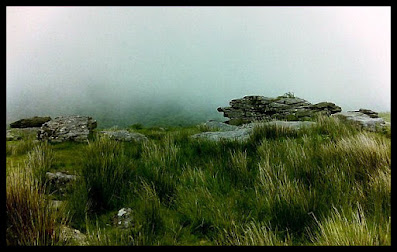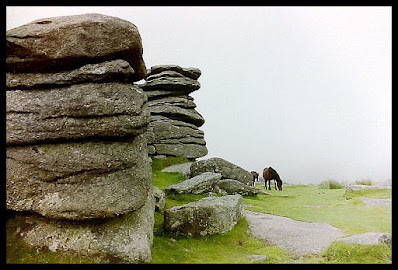Combestone is probably the most accessible tor on Dartmoor, being only a short distance from the road with its own car parking space...a rather funky, stone edged one at that!
It's difficult to say how many tors there are on Dartmoor. According to various accounts the amount varies from 147 to 433 or more. Anyway, this is just one of them, which I visited sometime around 2001 on a trip out with some friends. Even though near the busy main road, once amongst the granite rocks all thoughts of modern life melt away, almost transporting yourself back to an earlier time when people had to survive unaided upon the land.
Tors were formed by the process of rain water seeping through the upper layer of land and weathering the bedrock during prehistoric times, when forest covered the land. This affected the natural joints in the stone, and once exposed was accelerated by further weathering, particularly during the ice age when freezing water expanded the cracks. Rock formations on the crest of higher land and hills were the result of that action.
Dartmoor is an area of moorland covering 369 square miles. It became a national park in 1951, and although appears to be an extremely wild and untamed area of land, it has been lived and worked on since prehistoric times - reputedly the most extensive prehistoric remains in one area to be seen in Britain - encompassing the remains of later activities such as farming, quarrying and other local industries.
I came across these photos whilst sorting through a backlog of photos and negatives. Some of the prints had been scanned a while ago, one of which I use for my pc wallpaper (the first photo at the top of the page). However, some I'd cut up and used for an art project workbook, therefore I had to scan the negatives...hence the colour differences. My neg scanner has a mind of its own and seems to interpret what it thinks I want!
It was a very misty, soft summer day when I visited, which added to the mystique of the place.
Some of the delightful Dartmoor ponies were grazing around the rocks, below. The indigenous ponies have been here since prehistoric times, and are a particularly hardy breed. Although they live in herds naturally in the wild, the ponies are all owned by local farmers and breeders with local grazing rights, called Dartmoor Commoners. Allowed to graze throughout the year, the ponies are brought into the farms during the annual round-up in the Autumn, called a drift, when they are given health checks. The old and sick are taken from the herd, along with those who are to be sold, and the rest are released back to the moor. Although owned, most of the ponies aren't used to being handled so should be left alone.
And finally, one of the wind-blown hawthorn trees, accentuating the feeling of wilderness on this enigmatic moor.
Plus a couple more that I'd missed out! ;)















No comments:
Post a Comment